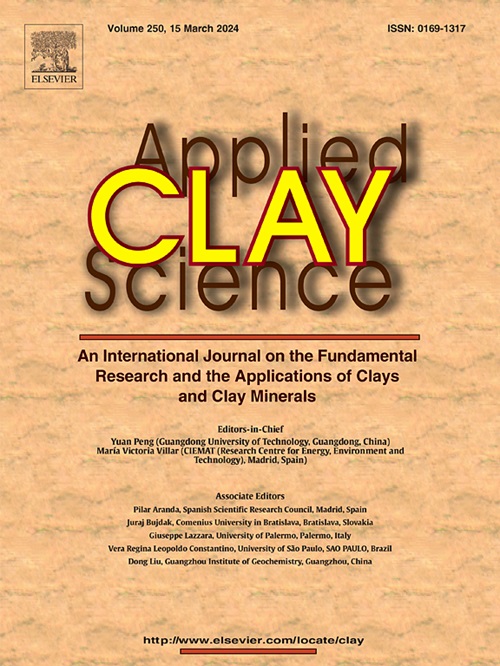Clay mineralogical and geochemical responses to weathering of intrusive vs. extrusive rocks under a subtropical climate
IF 5.8
2区 地球科学
Q2 CHEMISTRY, PHYSICAL
引用次数: 0
Abstract
Clay mineralogy and geochemical characteristics of two soil profiles developed on intrusive (quartz monzonite) and extrusive (rhyolite) rocks in subtropical China were investigated to reveal clay mineralogical responses to weathering of different parent rocks under a subtropical climate. Overall chemical weathering intensity and biotic weathering intensity do not show significant differences between the two profiles, suggesting that the difference in parent lithology and rock's cooling history did not exert a significant control on weathering intensity. The differences between two profiles are mainly reflected in clay mineralogy and evolution of elemental loss/gain. The soil developed on intrusive rock is characterized by having morphologically diverse halloysite, little chlorite, less illite, and poorly crystallized illite. Elemental addition/depletion shows evident differences between the two profiles. Differences in clay mineralogy and geochemical characteristics can be linked to parent lithology and magma cooling history, which influence texture, parent composition and condition of water-rock interaction. For example, beyond expectation, soil developed on extrusive rock is conducive to the formation of halloysite because prolonged water stagnation favors preferential transformation of feldspar into halloysite. In addition, for each profile, biotic weathering and abiotic weathering jointly determined the formation and transformation of clay minerals. The widespread presence of porous volcanic glass in the rhyolite-derived soil may provide favorable nutritional conditions for microbial growth, producing large amounts of organic acids, which are an important factor influencing the alteration of illite to secondary minerals.
亚热带气候下侵入岩与挤出岩风化的粘土矿物学和地球化学反应
研究了在中国亚热带地区侵入岩(石英闪长岩)和喷出岩(流纹岩)上发育的两个土壤剖面的粘土矿物学和地球化学特征,以揭示在亚热带气候条件下不同母岩风化对粘土矿物学的响应。两个剖面的总体化学风化强度和生物风化强度并无显著差异,表明母岩岩性和岩石冷却历史的差异对风化强度的影响并不明显。两个剖面之间的差异主要体现在粘土矿物学和元素损益的演变上。在侵入岩上发育的土壤具有形态多样的埃洛石、少量绿泥石、较少的伊利石和结晶不良的伊利石。两个剖面之间的元素添加/消耗显示出明显的差异。粘土矿物学和地球化学特征的差异可能与母岩岩性和岩浆冷却历史有关,而母岩岩性和岩浆冷却历史会影响质地、母岩成分和水岩相互作用条件。例如,出乎意料的是,在挤出岩上发育的土壤有利于埃洛石的形成,因为长时间的水滞留有利于长石向埃洛石的优先转化。此外,在每个剖面上,生物风化和非生物风化共同决定了粘土矿物的形成和转化。流纹岩衍生土壤中广泛存在的多孔火山玻璃可能为微生物生长提供了有利的营养条件,产生了大量有机酸,而有机酸是影响伊利石向次生矿物转化的重要因素。
本文章由计算机程序翻译,如有差异,请以英文原文为准。
求助全文
约1分钟内获得全文
求助全文
来源期刊

Applied Clay Science
地学-矿物学
CiteScore
10.30
自引率
10.70%
发文量
289
审稿时长
39 days
期刊介绍:
Applied Clay Science aims to be an international journal attracting high quality scientific papers on clays and clay minerals, including research papers, reviews, and technical notes. The journal covers typical subjects of Fundamental and Applied Clay Science such as:
• Synthesis and purification
• Structural, crystallographic and mineralogical properties of clays and clay minerals
• Thermal properties of clays and clay minerals
• Physico-chemical properties including i) surface and interface properties; ii) thermodynamic properties; iii) mechanical properties
• Interaction with water, with polar and apolar molecules
• Colloidal properties and rheology
• Adsorption, Intercalation, Ionic exchange
• Genesis and deposits of clay minerals
• Geology and geochemistry of clays
• Modification of clays and clay minerals properties by thermal and physical treatments
• Modification by chemical treatments with organic and inorganic molecules(organoclays, pillared clays)
• Modification by biological microorganisms. etc...
 求助内容:
求助内容: 应助结果提醒方式:
应助结果提醒方式:


